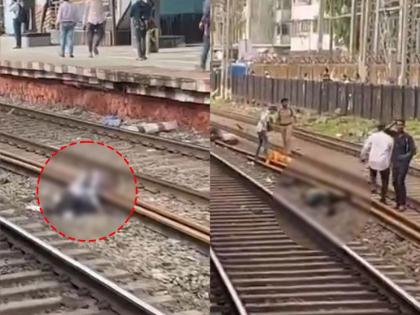Mumbai Local Accident: Activist Urges Railway Minister to Revive Rs 21,000 Crore Suburban Rail Overhaul
By Amit Srivastava | Updated: June 10, 2025 08:49 IST2025-06-10T08:43:15+5:302025-06-10T08:49:35+5:30
Mumbai: The deaths of at least four commuters on Central Railway tracks have once again spotlighted a long-ignored ₹21,000 crore ...

Central Railway Slammed for Sitting on ₹21,000 Cr Safety Plan Since 2016
Mumbai: The deaths of at least four commuters on Central Railway tracks have once again spotlighted a long-ignored ₹21,000 crore suburban rail makeover plan proposed by an expert committee in 2016.
Civic rights activist B N Kumar, who runs the ‘Human Chain’ forum, has written to Railway Minister Ashwini Vaishnaw urging immediate implementation of the plan. “The report warned that the suburban train system was operating at 400% over its capacity. If no action is taken, the situation could become explosive by 2030,” Kumar stated in his appeal, which he has also posted on the PMO's public grievances website.
Kumar emphasized that daily commuters are forced to risk their lives due to chronic uncertainty around train timings. “People cling to overcrowded trains because they fear being late to work and are unsure when the next train will arrive,” he said.
The “Report on Review of Rising Trend of Accidental Deaths in Mumbai Suburban System” remains shelved, even as fatal accidents continue. Kumar, who launched the award-winning #MissionMumbaiLocal campaign in 2016, said overcrowding is largely due to poor punctuality and an acute shortage of rakes and stabling lines.
A key recommendation of the committee was the creation of a loop system—allowing terminating trains to circle around and return via alternate tracks and platforms, thereby reducing congestion. Under the current system, terminating rakes must reverse direction to vacate platforms, causing a back-to-back pile-up of trains and worsening delays.
The report suggested constructing underground loops using available land at the extended CSMT premises. It also proposed shifting slow lines underground to form a six-line loop system between up and down lines. For the Panvel corridor, the committee recommended extending services to Karjat and Roha—steps that could allow a 20% increase in slow line services at CSMT, Thane, Kalyan, Karjat, and Kasara.
Kumar recalled that the committee was set up in 2015 by the then Railway Minister Suresh Prabhu following a public outcry over the death of commuter Bhavesh Nakate, who fell from a speeding train near Thane. The viral video of his death prompted Prabhu to direct Central and Western Railways to develop action plans to prevent such tragedies.
The report, backed by then MPs Kirit Somaiya, Poonam Mahajan, Arvind Sawant, Rajan Vichare, and municipal commissioners of Mumbai, Thane, and Kalyan, included a detailed ₹21,000 crore upgrade blueprint. Recommendations included acquisition of 150 new rakes, construction of stabling lines, track fencing, road overbridges, and a disaster management system.
As of 2015, CSMT saw the highest number of terminating trains at 465, followed by Thane (395), Panvel (274), Kalyan (194), and Vashi (181). To decongest these stations, the report proposed building auxiliary platforms—measuring 40m x 400m and 6m high—to complement the existing narrow ones.
“It's time to dust off the report and act before more lives are lost,” Kumar urged.
Open in app